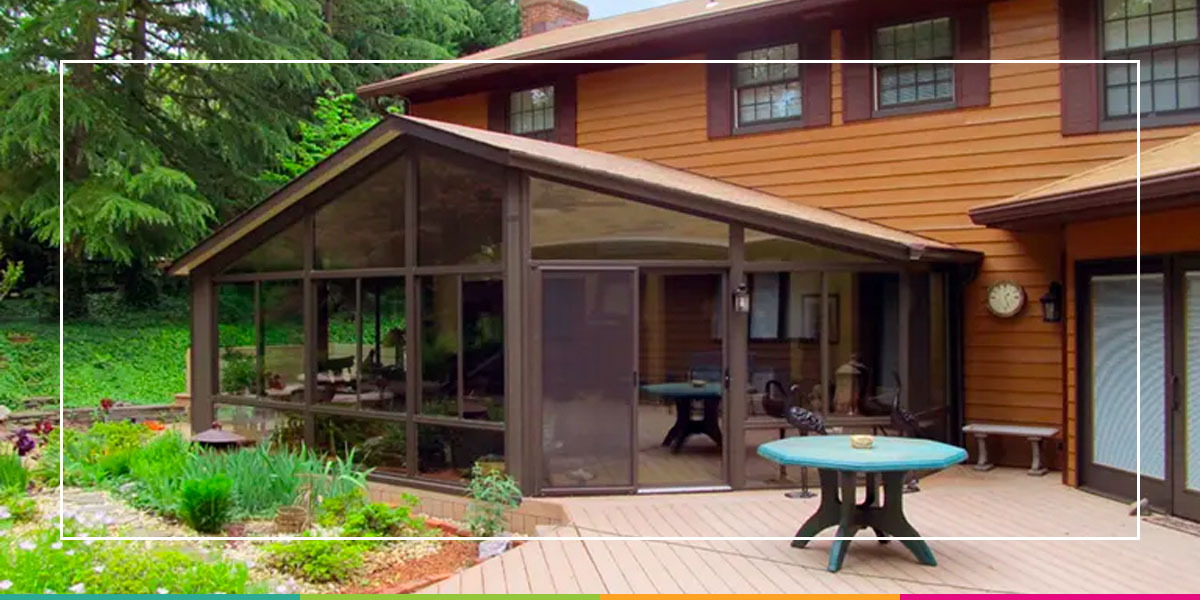
Insulating your sunroom allows you, your family and guests to enjoy the additional living space all year round. Planning the interior design of this space to fit your styling choices is one of the most significant benefits of having your sunroom. However, before picking out what paints will make your sunroom stand out, take some time to learn the sunroom insulation requirements to ensure you’re cool in the summer and warm in the winter.
Follow the steps below to keep a comfortable temperature in your sunroom all year round. Say goodbye to fluctuating temperatures and hello to a beautiful living space for you and your guests to enjoy. Sunroom insulation comes in many forms that can enhance the visual aesthetic of your living space and provide comfortable temperatures throughout the year. Get started on energy savings today by following the upcoming tips.
Sunroom Insulation Requirements
Insulation is essential for any new home addition. For a sunroom, it is crucial to take the proper steps to ensure your space receives as much support as possible when regulating temperatures all year round. When building an insulated sunroom, a professional contractor will ensure that your new lounge or entertainment area has the suitable material and tools to create a comfortable atmosphere in intense weather conditions.
Before they begin installing, you can become familiar with the techniques for insulating your sunroom.
1. Ceiling Insulation
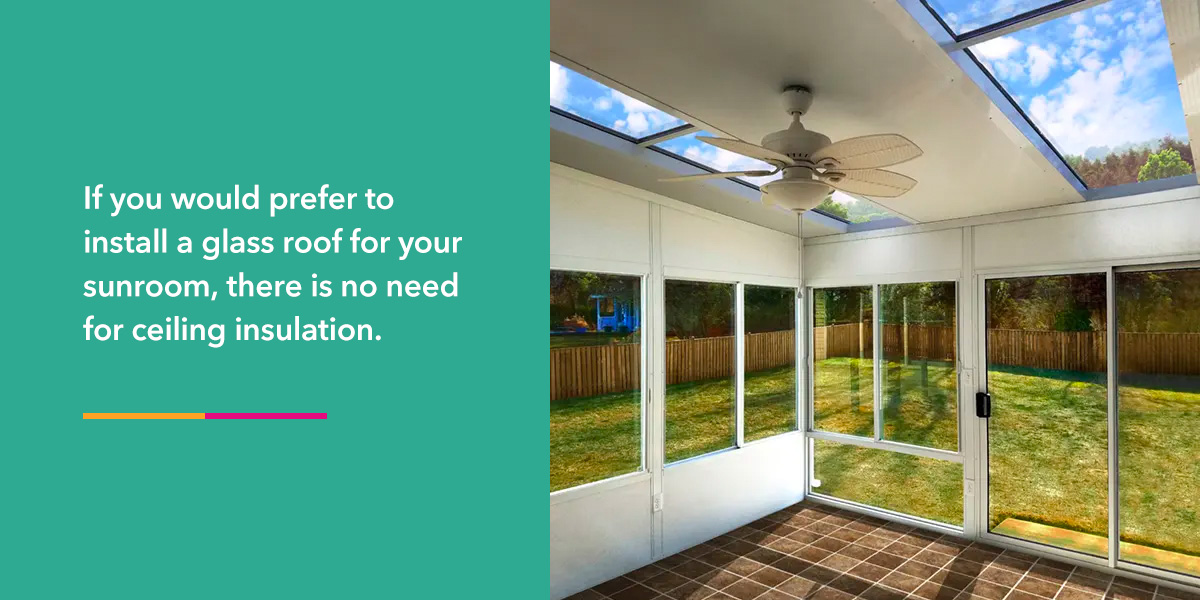
Ceiling insulation depends on the vision you have for your new sunroom. Some homeowners prefer to have a glass roof to match the exterior walls of the sunroom. Others opt for a similar roof to their homes to create a consistent style for the whole property.
If you would prefer to install a glass roof for your sunroom, there is no need for ceiling insulation. A professional will use insulation to protect your space from intense temperatures and weather conditions if you would rather have a shingled roof. A contractor will insulate the ceiling using a material that absorbs hot and cold temperatures to ensure your space is as comfortable as possible throughout the year.
With added insulation from the wall that attaches your sunroom to the rest of your home, these two insulation jobs will provide a relaxing area for you and your family every month of the year.
2. Window Insulation
Weatherstripping and plastic film insulation are two of the best ways to insulate sunroom windows after building a new addition to your home.
- Weatherstripping: For sunrooms that have moveable windows and doors, weatherstripping is the most effective way to block hot and color air from entering your living space from outside.
When building your sunroom, you can ask the contractor to include weatherstripping on your windows as the project reaches its final steps. The cracks between the frames and the moveable components of your sunroom can sometimes let in air if they are not tight enough. Weatherstripping saves you from feeling the fluctuating temperatures from these drafts and conserves energy by insulating the air inside.
Most contractors use vinyl, felt or foam for weatherstripping material for effective window insulation. For non-moving components such as the glass walls, caulk will work perfectly for stopping any air from penetrating the divides between glass and interior walls.
- Plastic insulation: Applying a thin layer of clear plastic insulation to your stationary glass walls and windows can prevent drafts throughout the year. This process is energy efficient and only takes a few minutes to place over your glass. You can see outside into your yard while staying cool in the summer months and warm in the winter.
Learn More About Our Product Offerings
3. Calculating R-Value
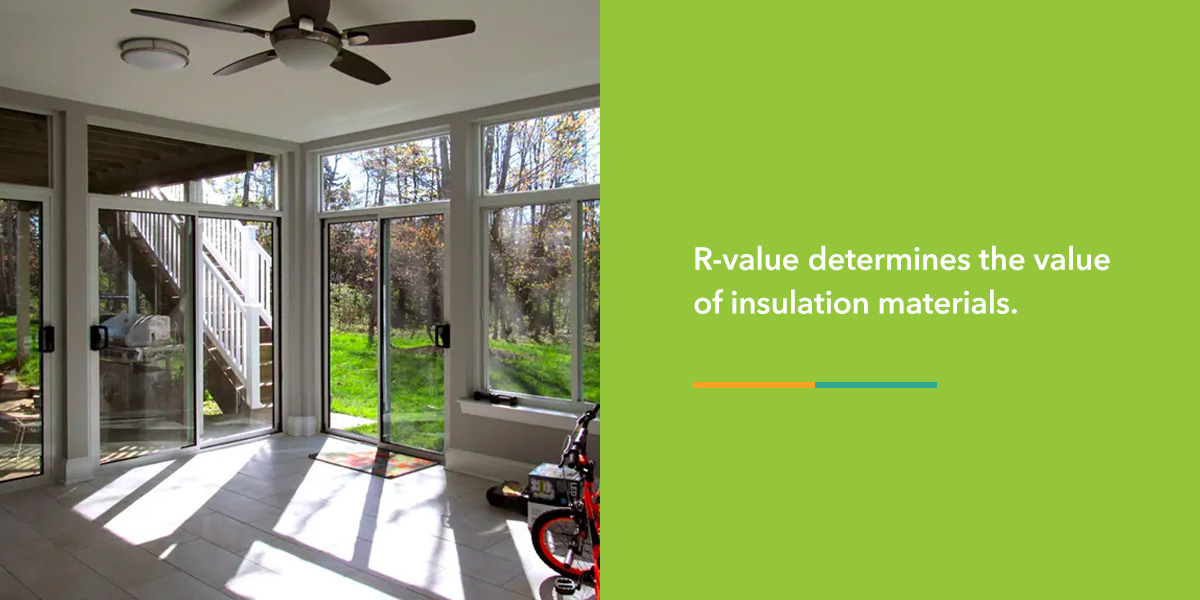
Before making any insulation plans, it is essential to calculate the insulation R-value you need for your sunroom. R-value determines the value of insulation materials. This factor allows you to measure how efficient insulation can utilize the thickness of your walls or floors to fight against the temperature of your geographic location and the airflow penetrating your living space.
R-value for walls typically ranges from R13 to R21, with the lower number measuring a thinner density than its counterpart. For any geographic location in the United States, a 2-by-4 foot wall works best with R13 and R15 insulation. A 2-by-6 foot wall can withstand more density from R19 to R21.
For floor insulation, R-value ranges from R13 to R30. This difference in thickness depends on the location of your home. If you live in Texas or Florida, the heat will only require R13 insulation for your sunroom. Southern states and California will need R25 insulation to effectively block out the heat and chill year-round. Any residence north of these can use any insulation between R25 and R30 due to the natural cold of these locations.
Keep your location in mind when choosing the insulation you need for your sunroom so you save energy every season.
4. Fiberglass Insulation Sheets
Fiberglass is popular among contractors insulating walls. When building a sunroom, you can choose to add newly insulated walls that connect to your home for more privacy and added heat in colder climates. The wall that your sunroom connects to will already have insulation. However, if you want to add more walls that hold glass windows for your sunroom, you will most likely begin to see the benefits of fiberglass insulation sheets.
Fiberglass insulation typically comes in two different forms. Your contractor will choose between installing insulation as loose fill or blanket. Blanket fiberglass insulation, also known as fiberglass batt, is the most common insulation type in the United States. This form of insulation ranges from R13 to R30 to fit the density of typical residential house walls.
Contractors will apply fiberglass in precut sheets that easily fit into the wall’s cavity to separate the exterior and interior of the home. Loose fill insulation has a higher range of R-value, around 30 to R50.
Sunroom Insulation Tips
No matter your geographic location, your sunroom can benefit from a few of these temperature-regulating tips. You can feel comfortable in your living space throughout every month of the year by investing in a few decorative items that enhance the aesthetic of your home addition.
1. Window Tinting
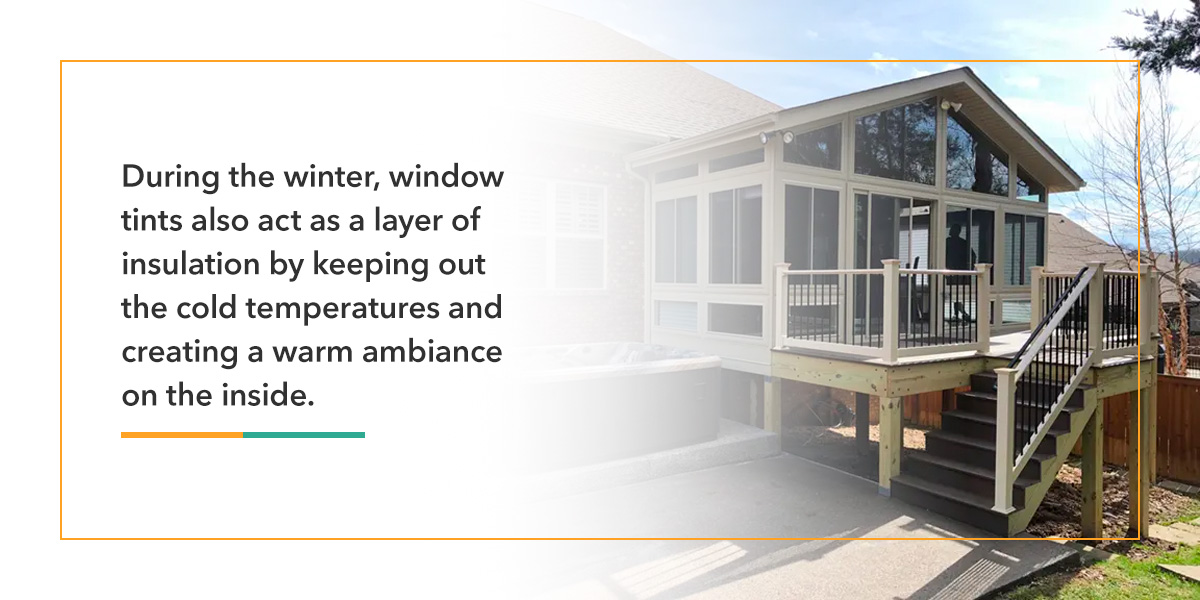
Tinting the windows in your sunroom prevents intense UV rays from coming into your living space. Glass traps heat for long periods, creating an uncomfortably humid and hot room. The sun’s rays also cause furniture to age faster as the color fades from the light. You can protect your belongings and regulate the temperature of your sunroom by applying window tints to exposed glass.
You may be skeptical about using tints on your windows if you enjoy taking in the view of your yard each day. Rest assured that window tints do not have to block the scenery outside. Even a slightly darker shade than your current windows helps block out the heat from the sun’s rays enough to cool your sunroom in the summer.
During the winter, window tints also act as a layer of insulation by keeping out the cold temperatures and creating a warm ambiance on the inside. You can relax with a cup of cocoa in your sunroom, knowing the chilly air will remain outside.
Learn More About Our Product Offerings
2. Ceiling Fans
Installing a ceiling fan in your sunroom is an efficient step toward regulating temperature in your home all year round. Giving the air inside the chance to move instead of hanging in the atmosphere can make your space feel breezy. You will not have to worry about your sunroom becoming muggy in spring or humid in the fall.
Ceiling fans are also excellent tools for enhancing the visual aesthetic of your sunroom. You might find a fan that matches your walls, floor or decor to make your space stand out.
3. Insulated Drapes
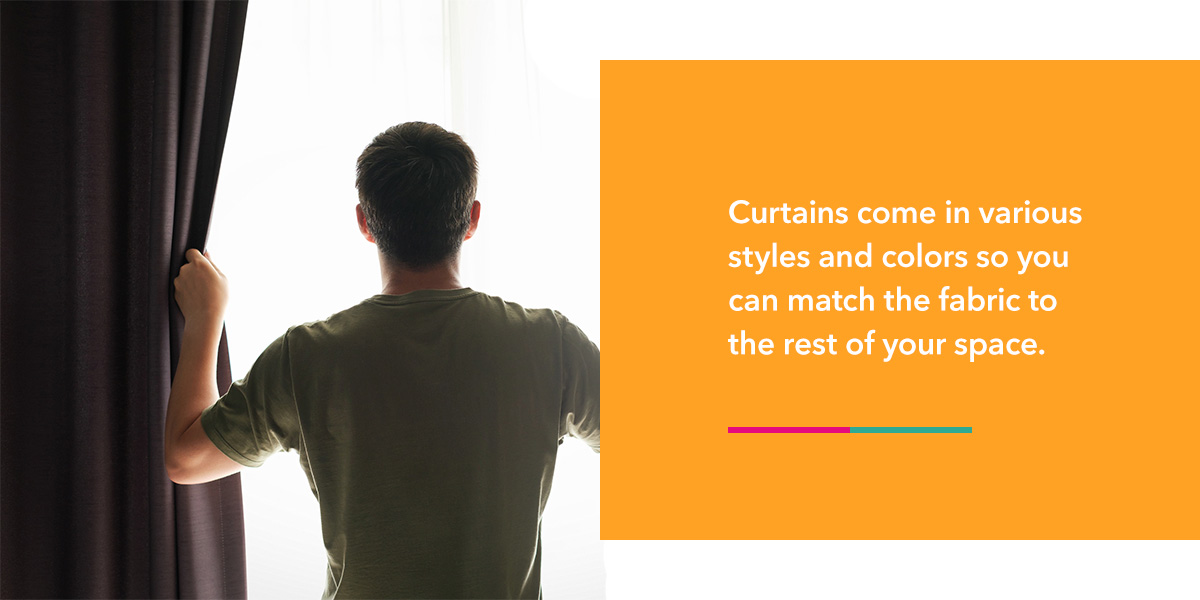
Similar to window tints, insulated drapes protect your furniture and decor from fading due to intense UV rays. Investing in insulated drapes can effectively block the heat from the sun while providing your space with a beautiful addition to your aesthetic visions. Curtains come in various styles and colors so you can match the fabric to the rest of your space.
While the drapes block the view outdoors more than window tints, you can keep them open during the winter to provide a clear view of the snowy weather as neighbors build snowmen and have snowball fights. If you prefer to see your yard all year round, you can invest in mesh material insulated drapes. The see-through material of these curtains allows you to see more of your property without feeling the sun’s intense heat. This rule also applies to colder months when blocking out the chilly air.
4. Flooring
The floor of a sunroom can significantly change the temperature of your living space. Many homeowners opt for electric baseboard heating so their floors are never cold first thing in the morning and the heat can rise throughout the room. Electronic baseboard heating also takes up only a small space, so you can continue to enjoy your sunroom without having to move around this object.
If electric baseboard heating is not for you, installing carpet in your sunroom can absorb heat during colder months and provide a soft-to-the-touch floor for all seasons.
5. Space Heaters or an Electric Fireplace
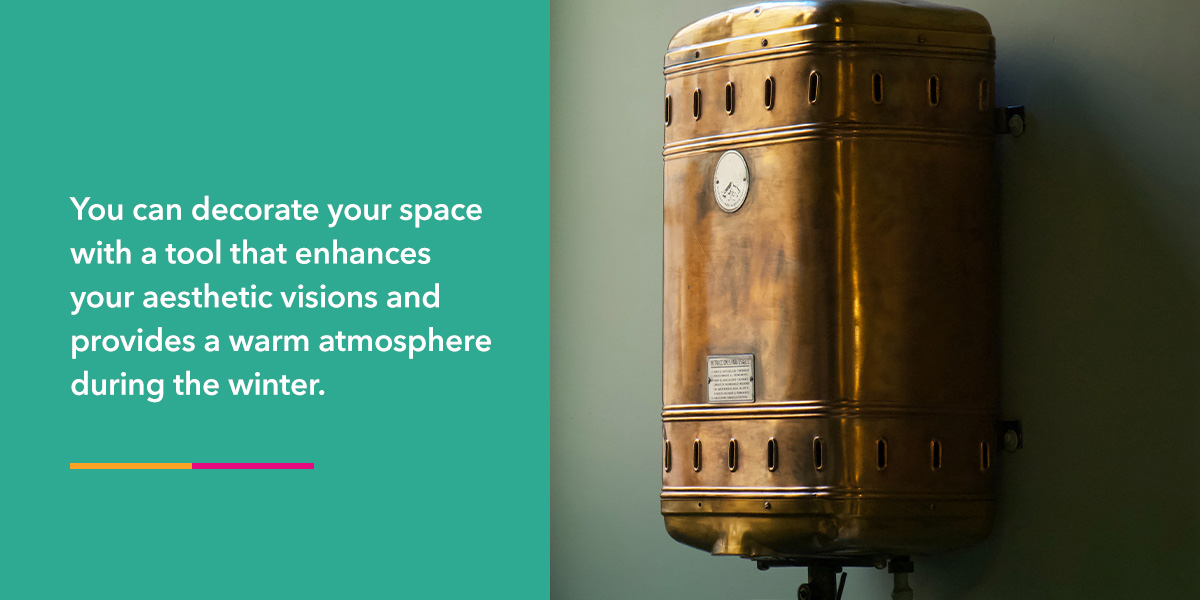
Fireplaces are beautiful additions to any room. You can decorate your space with a tool that enhances your aesthetic visions and provides a warm atmosphere during the winter. Fireplaces range in size, and some are as small as nightstands, but they can vary in width to fit the length of your wall.
Space heaters are great tools to install in your sunroom if you prefer more space in your sunroom for furniture and decor. Space heaters can attach to a wall or ceiling to create a warm atmosphere. These objects are small enough to hide in plain sight for a minimalistic approach to your heating needs.
6. Paint Walls
Some paint colors can absorb heat or create a cooler atmosphere for your sunroom. Depending on your styling preferences, you can utilize paint colors to stabilize temperature throughout the year.
If you live in a warmer climate, you should consider painting your sunroom a lighter color. White, cream, light green and blue or other neutral colors reflect UV rays to minimize trapped heat in a living space. If you still want to incorporate warm tones into your sunroom without trapping more heat, many homeowners opt for a yellow paint color that effectively reflects the sun.
Darker colors absorb heat for extended periods if you live in a colder climate. Deep blues, grays, blacks and reds do not reflect UV rays and can provide your sunroom with extra warmth when needed.
You can also invest in thermal paint that helps homeowners regulate the temperature in their sunroom. These paints add an extra thin layer of protection from UV rays so you keep your space cool during the summer.
7. Indoor plants
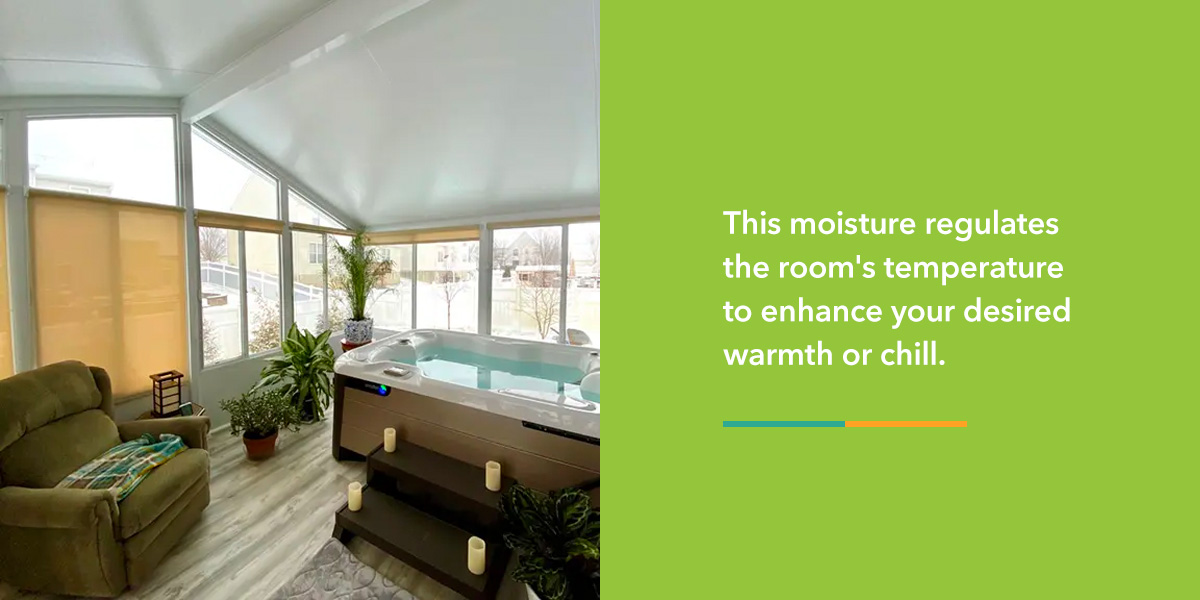
Plants are a great decoration choice for any room in the house. Greenery can make your sunroom come to life as it benefits from the indirect sunlight from the windows. As you allow them to grow in a protected environment, indoor plants also help you with insulation. Plants release moisture each day as you continue to water them. The moisture evaporates from the leaves and enters the air. This moisture regulates the room’s temperature to enhance your desired warmth or chill.
Investing in a few indoor plants for your sunroom can establish a healthy atmosphere for your living space through fresh air and comfortable temperatures all year round.
Learn More About Our Product Offerings
Sunroom Insulation Guide
If you notice that the sun coming through your sunroom windows can make your living space hot in the summer months and the lack of UV rays in the winter months make the room too cold, then insulating your sunroom can solve these pressing issues.
Insulation regulates the temperature in your home to lower the cost of heating and cooling each season. Consider the following scenarios to see how insulation makes your sunroom as comfortable as possible throughout the year.
How to Insulate a Sunroom for Winter
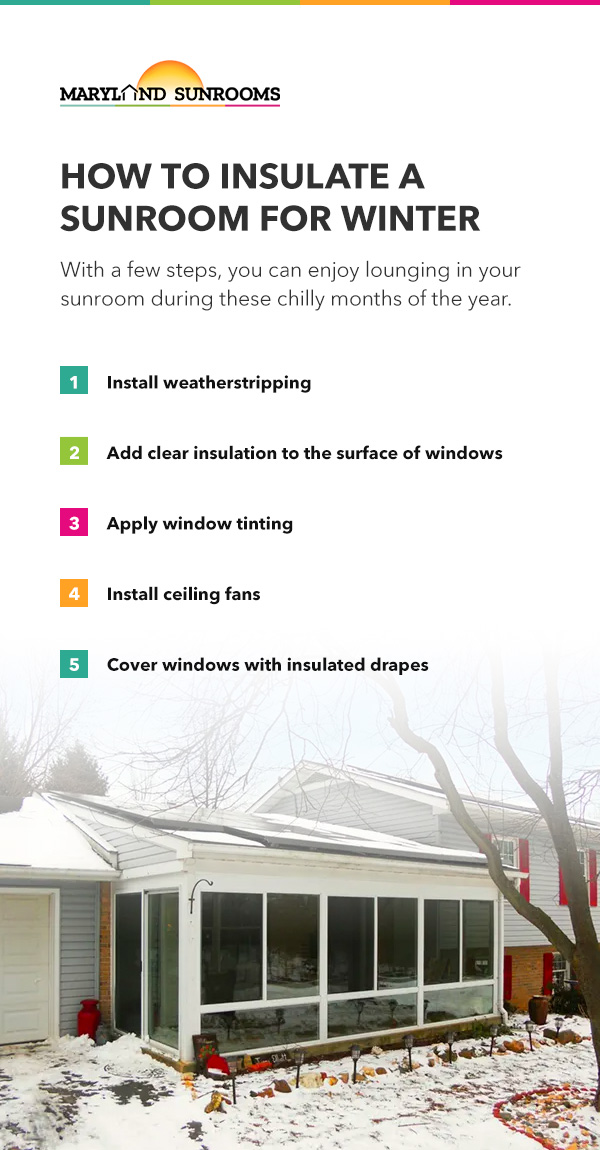
The cold winter air can feel intense when trapped in one space. With a few steps, you can enjoy lounging in your sunroom during these chilly months of the year.
- Install weatherstripping: Weatherstripping benefits homeowners during any season. Air leaks that enter the house through the crack between walls, doors and windows can make any room feel warmer or colder than average. To prevent this chilly draft during the winter, install weatherstripping material to any window or door in your sunroom. This process takes less than an hour to complete, so you can get back to enjoying your new lounge space as soon as possible.
- Add clear insulation to the surface of windows: A thin layer of transparent plastic insulation can make a significant difference for any room in the house. Investing in shrink wrap to tape around the corners of the glass in your sunroom can effectively block out the chill that windows absorb during the winter. The clear material allows you to maintain a continuous view of your yard while you relax in your sunroom and save money on energy costs.
- Apply window tinting: Like transparent plastic insulation, window tinting effectively blocks out cold temperatures during winter so you can lounge comfortably in your sunroom. While plastic insulation works just as effectively as window tinting, its counterpart adds a sleek finish to any glass in the room to provide a touch of modern aesthetic. Window tinting may be the right move for you if you prefer to install a more natural look to your windows.
- Install ceiling fans: During any season, heat rises to the ceiling of your rooms. To prevent an imbalance of heat in your sunroom, you can install a ceiling fan. When turned on, the blades will spin clockwise to push air down to the floor.
- Cover windows with insulated drapes: Whether you plan to install smaller windows in your sunroom or have glass walls surrounding your new home addition, insulated drapes can provide any transparent threshold with added protection from cold temperatures. The thick material of these curtains absorbs chilly air, so you will not have to feel it in your sunroom. With insulated drapes, you can comfortably enjoy your new space with regulated temperatures and admire a stylish look in your sunroom.
How to Keep Your Sunroom Cool in the Summer
Here are three tips to keep your sunroom cool in the summer:
- Increase airflow: Keeping the air moving in the summer is essential for maintaining a cool temperature throughout the heated months. Even if you are relaxing in a glass room that absorbs the sun’s UV rays, you can use ceiling fans and air conditioning to keep your space chilled. Ceiling fans are great for all months of the year. In the summer, you can switch the direction of the blades to spin counterclockwise to push warm air toward the ceiling. This step allows you to bask in the cooler air during the year’s hottest days.
- Use window tinting: Window tinting is just as effective in summer as in winter. During the warmer months, window tints trap the heat so the sun’s impact cannot make it into the sunroom. You can also maintain a clear view of your yard at all times to enjoy the gorgeous summer days from the comfort of your sunroom.
- Install blinds: Blinds are a stylish choice that blocks intense heat from entering your sunroom. You can ensure a longer life for your furniture by installing these over your glass.
How to Insulate Under a Raised Sunroom
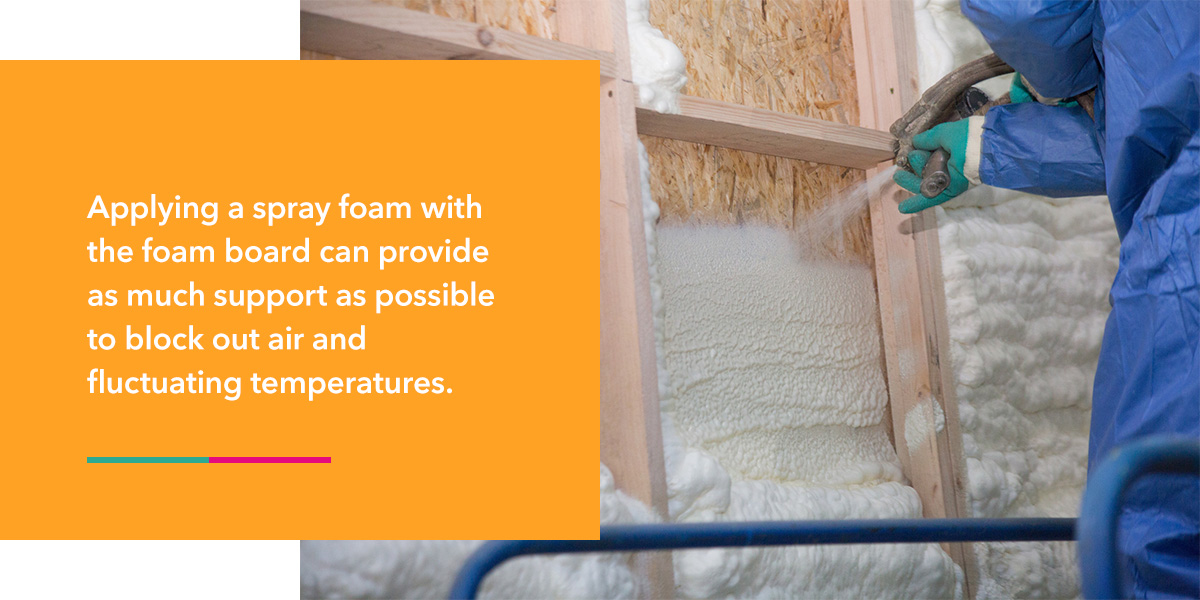
Insulating under an enclosed porch or a raised sunroom allows you to conserve energy starting from the floor. To do this, you can invest in a good foam board brand to install underneath the room. Applying a spray foam with the foam board can provide as much support as possible to block out air and fluctuating temperatures. Finish up with durable plywood and caulk to complete the insulation.
Cost to Insulate a Sunroom
The cost of insulating a sunroom depends on the type of insulation a contractor uses, the R-value and how much space it will take up. Precut sheets of fiberglass with an R-value of R13 typically cost $0.20-$0.40 per square foot, whereas thicker loose fill fiberglass insulation can round up to around $2.00 per square foot with an R-value of R30-R50.
Contractor teams can also consider your budget when finalizing prices so you can feel comfortable with the final product. Take some time to research these prices to compare them to your spending limit.
Learn More About Maryland Sunrooms Home Additions
Are you interested in building your dream sunroom? Maryland Sunrooms can help make your visions come to life. We take great pride in including you in every step of our installation process to ensure you are in love with the final product. At Maryland Sunrooms, we provide quality services and lifetime warranties for homeowners in Frederick, Baltimore, Gaithersburg, Silver Spring, Columbia, Hagerstown, Columbia and surrounding Maryland areas.
Request your design consultation today to see how your aesthetic visions can come to life. Our sunrooms offer comfortable temperatures year-round, so you can relax in your new space during the hottest and coldest months of the year.
Contact us today with any questions.
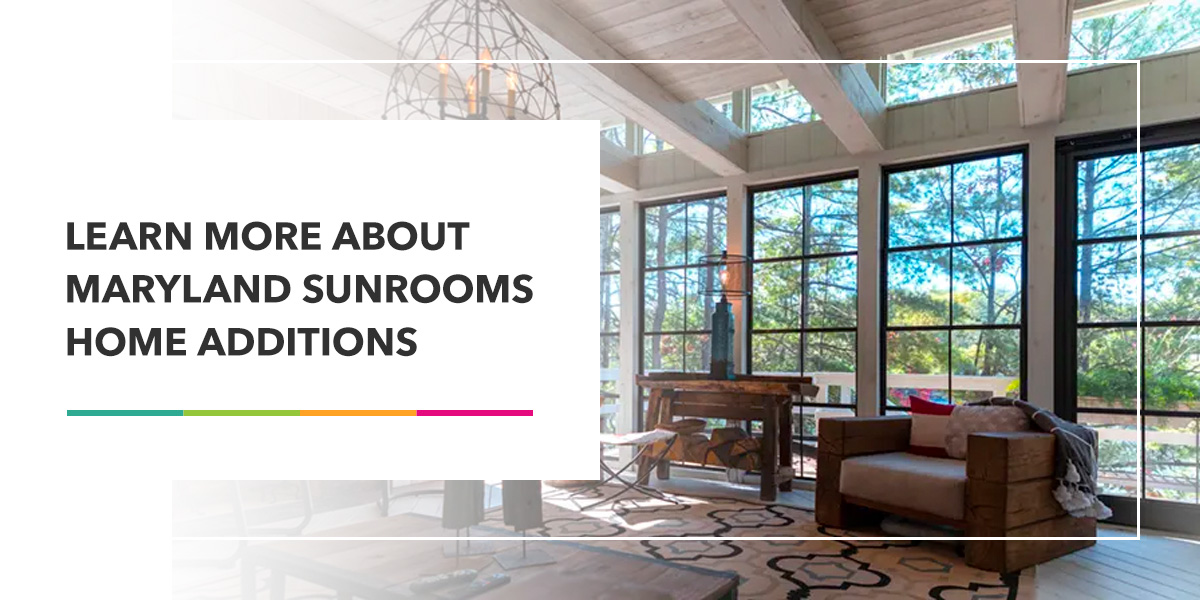

Julie Shetter is the Marketing Director at Maryland Sunrooms. She has over a decade of experience in the home improvement and sunroom industry.

